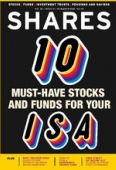Archived article
Please note that tax, investment, pension and ISA rules can change and the information and any views contained in this article may now be inaccurate.
Ignore short-term noise and buy dynamic, data-driven RELX

KEY DATA
RELX (REL) £17.57
2021 PE: 23.9. 2021 Yield: 2.8%
Source: Refinitiv
Shares in information services business RELX (REL) have lagged the FTSE 100 since the market shifted its focus to cheap value stocks following the vaccine breakthroughs in November 2020.
Relative share price weakness represents an excellent opportunity to buy shares in this high-quality business. It is at the forefront of analytics – the increasingly crucial role of identifying, interpreting and communicating meaningful patterns in data which organisations can use to forecast and improve performance.
The shares trade on nearly 24 times forecast earnings per share, which is not overly expensive given the long-term potential for the business to deliver consistent growth.
HOW DOES IT MAKE MONEY?
Formed nearly 30 years ago by the merger of publishing groups Reed International and Elsevier, the company has increasingly moved away from print products to become a more digital operation.

The group generates 60% of its revenue from subscriptions – supporting visibility on future income. The rest of its sales come from transactional activities (39%) and advertising (1%).
RELX can take in large data sets and distil the information to remove irrelevant and unreliable data and deliver focused analysis to its client base.
For example, this could mean helping a cancer treatment centre understand the outcomes for its customers and get the latest information on treatments and diagnostics to help improve levels of care. Or it might be supporting online classified ads platform Gumtree in weeding out fraudulent accounts.
RELX says: ‘Our products often account for less than 1% of our customers‘ total cost base but can have a significant and positive impact on the economics of the remaining 99%.’

WHAT IS THE STRATEGIC PLAN?
The focus is on organic growth underpinned by developing sophisticated analytics tools to adapt to the needs of its customer base.
As chief financial officer Nick Luff tells Shares it is a question of prioritising the right areas. ‘To make those decisions you need to know what data is available and be close enough to your customers to know what problem you are trying to solve.’
Luff explains this internally driven expansion should continue to be supplemented by modest-sized acquisitions.
The company remains committed to its exhibitions arm, despite the impact of Covid clouding the near-term outlook, with virtual events potentially making a larger contribution over time. Numis analyst Steve Liechti says: ‘RELX is still experimenting to find out what is most helpful/valuable and, importantly, what people will pay for.’
TRACK RECORD AND NEAR-TERM PROSPECTS
RELX has an excellent track record of share price, operational and financial performance going back at least a decade.
‘The company has demonstrated the ability, on an underlying basis, to deliver around 4% revenue growth, 6% operating profit growth and 8% earnings per share growth in recent years. Scaling the footprint of its electronic information businesses should provide scope for further gradual acceleration in the medium term,’ says investment bank Berenberg.
Based on consensus forecasts earnings are expected to recover sharply in 2021 but won’t surpass 2019 levels until 2022. This reflects ongoing pressure on its exhibitions arm and a currency headwind.
WHO IS IN CHARGE?
The consistency in performance has been mirrored in the leadership of the group. Chief executive Erik Engstrom has been in place since 2009 and previously headed up the Elsevier science journals business. Numbers man Luff has been in situ since 2014. Chairman Paul Walker took up his position in March 2021, replacing Anthony Hapgood who had been in the role for more than a decade.
HOW STRONG IS THE BALANCE SHEET?
Net debt totalled £6.9 billion as of 31 December 2020. According to Numis’ Liechti, ‘Debt is relatively high, though RELX has no covenant issues, good access to capital markets and strong banking facilities.’
KEY RISKS
A perceived threat is the impact of open access – the principle of giving away publicly-funded peer-reviewed research for free – on subscriptions in its science, technical and medical division and more specifically its Elsevier operation.
Luff says this misunderstands RELX’s role which is organising the delivery and vetting of this research whether it is paid for by the author or by the subscriber.
‘We do either,’ he says. ‘We’ll do open access, but our subscription revenue is also growing fast.’
In 2017 universities in Sweden and Germany cancelled subscriptions in a dispute over the cost of access to journals but Luff says this has occurred where institutions were on ‘the wrong side of either model’ or in other words not getting paid for their own research and having to pay for outside journals. ‘We’ve found ways of accommodating different institutions,’ he adds.
While RELX continues to generate high margins in its Elsevier business, questions over access to research and its impact on profitability may continue.
The other major risk, given the centrality of data to the business is a serious cyber security failure or data breach.

SHARES SAYS: In balance, we think the shares are a compelling investment. Buy and hold for the long-term.
Important information:
These articles are provided by Shares magazine which is published by AJ Bell Media, a part of AJ Bell. Shares is not written by AJ Bell.
Shares is provided for your general information and use and is not a personal recommendation to invest. It is not intended to be relied upon by you in making or not making any investment decisions. The investments referred to in these articles will not be suitable for all investors. If in doubt please seek appropriate independent financial advice.
Investors acting on the information in these articles do so at their own risk and AJ Bell Media and its staff do not accept liability for losses suffered by investors as a result of their investment decisions.

 magazine
magazine








